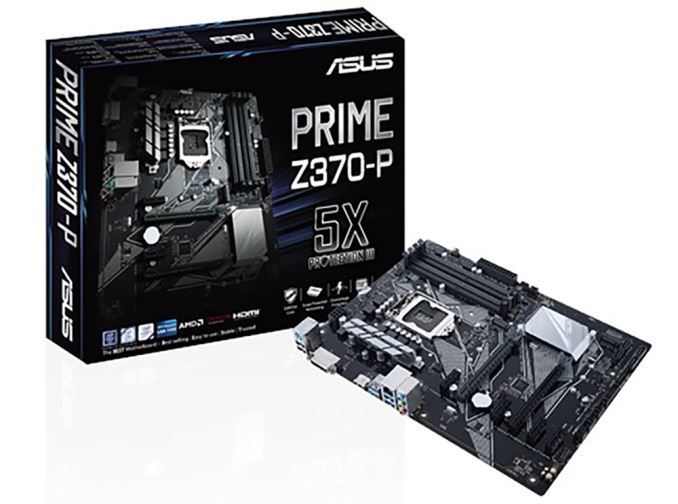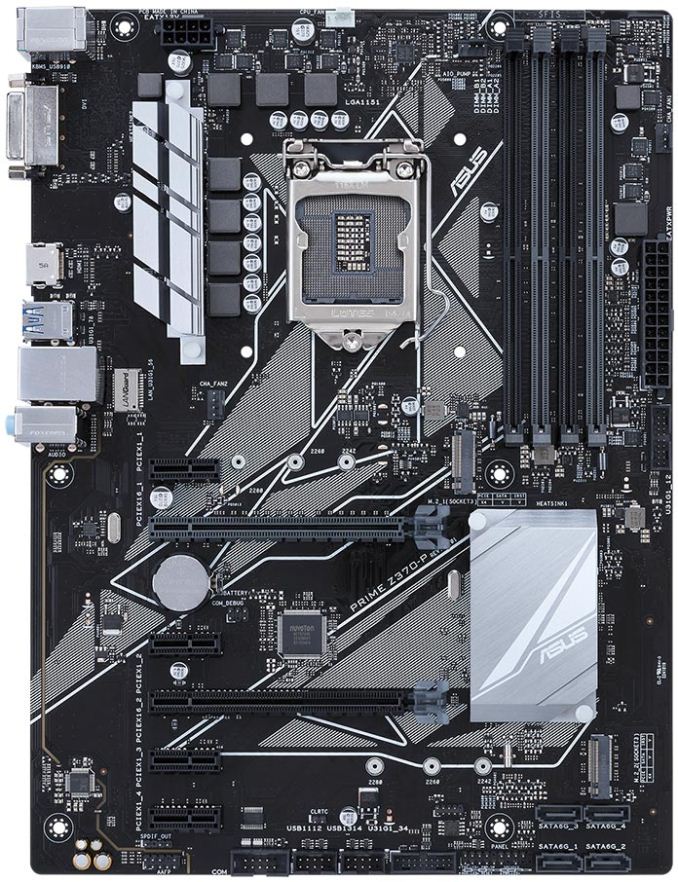Analyzing Z370 for Intel's 8th Generation Coffee Lake: A Quick Look at 50+ Motherboards
by Ian Cutress, Anton Shilov, Joe Shields & Gavin Bonshor on October 20, 2017 2:00 PM ESTASUS PRIME Z370-P
Following on from the second of two Prime branded boards at launch, the Z370-P has a completely different emphasis altogether. The priority has been shifted towards a broader focus on pure value, and the Z370-P comes in at the lowest price of all the ASUS Z370 motherboards. In comparison to the Z370-A Prime board, the Z370-P is considerably stripped down from all the bells and whistles, with this board sitting firmly on its laurels of a base Z370 motherboard but with ASUS optimizations.
This entry-level offering features a full sized ATX frame with four DIMM slots supporting up to DDR4-3866 with a maximum capacity of 64GB in total across all four DIMMs. This board is the only across the entire ASUS launched range not to feature Intel’s I219-V Gigabit network controller, instead opting for a more value orientated Realtek controller. Along with the TUF Gaming pairing, the Z370-P makes use of the more cost-effective Realtek ALC887 audio codec, and in this case, there is no EMI shielding. Dotted around the PCB, there is a dedicated header for AIO CPU cooling in addition to three 4-pin PWM compatible fan headers.
For the storage, the board uses a pair of M.2 PCIe x4 slots, with one either side of the full-length PCIe slots. This comes along with four SATA ports sticking out of the board on the bottom right. For PCIe slots, the top slot is a full-length PCIe 3.0 x16 slot whereas the second full-length slot is pulling its lanes directly from the chipset (PCIe x4). This means that only two-way Crossfire is possible using the latency added chipset based PCIe slot. The Prime Z370-P also has four PCI x1 slots in total.
The rear IO has four USB 3.1 (5 Gbps) Type-A ports and two USB 2.0 ports, and the board also has additional headers for four USB 3.1 (5 Gbps) ports and four USB 2.0 ports. The video comes via HDMI and a DVI-D port, which leaves the 2.1 audio jacks, a combination PS/2 port, and a network port.
While the Z370-P is not the most exciting board in the range, it covers the basics and users will be considering it as one of the cheapest entries into Coffee Lake and the Z370 chipset. While it has lower specifications than the Prime Z370-A, we expect it to be picked up by budget system builders using singular graphics configurations.













83 Comments
View All Comments
tommythorn - Monday, October 23, 2017 - link
While that feature page is great, the thunderbolt part is slightly misleading as a few of them supports it via an add-in-card. The page only lists the one that has it built-in. (The lackluster support for TB3 as well as 10 GbE is disappointing).OFelix - Saturday, October 21, 2017 - link
ThanksStochastic - Friday, October 20, 2017 - link
Would you consider putting out some simple Wirecutter-style recommendations? A lot of people (including myself) would like someone else who is better informed to simplify the decision-making process.Ian Cutress - Friday, October 20, 2017 - link
When we get our Z370 reviews underway, we'll start doing some buyers guidesStochastic - Friday, October 20, 2017 - link
Great, thanks!IGTrading - Sunday, October 22, 2017 - link
When do we get a 50+ AMD motherboard article guys ? :)abrowne1993 - Friday, October 20, 2017 - link
Okay but which one looks the coolest?dave_the_nerd - Friday, October 20, 2017 - link
"Whoever thought this was a good idea at Intel needs to be fired."Well... gee... why don't you tell us how you really feel?
DigitalFreak - Friday, October 20, 2017 - link
This whole notch thing makes me wonder if the 8xxx series was originally supposed to work in existing motherboards, but Intel ran into issues at the last minute.KaarlisK - Saturday, October 21, 2017 - link
Honestly, I cannot see the issue. The pins were changed so that nothing bad will happen if you put the wrong CPU in the wrong motherboard.As for the notches, I for one am happy that they were not changed. This means they can reuse the physical design, which lowers validation costs, which makes the CPUs cheaper.